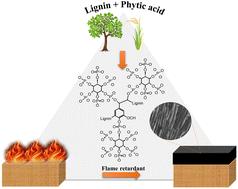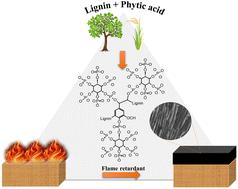作为热稳定阻燃材料的植酸衍生木质素
IF 11.3
1区 化学
Q1 CHEMISTRY, PHYSICAL
引用次数: 0
摘要
含磷阻燃剂因其出色的阻燃性、更强的热稳定性和有限的有毒烟雾排放而备受关注。生物基含磷阻燃剂可为这些材料带来环境效益、可再生性和可持续性。木质素是一种利用率低但资源丰富的可持续材料,可用于实现这一目的。在本研究中,在水性体系中,牛皮纸木质素(KL)和植酸(PHA)在低温下进行了简便的无溶剂缩聚反应,生产出了木质素衍生阻燃剂。该反应的优化条件为 1/0.4 mol/mol KL/PHA、pH 11、20 °C 和 20 分钟。通过利用先进的核磁共振(H、P 和 HSQC)、XPS 和傅立叶变换红外技术,证实了 PHA 的磷与 KL 脂肪族和芳香族羟基的氧共价键。C-P-O 和 P-O-P 键使产品具有较高的分解温度(Tmax)、较高的玻璃化转变温度(Tg)并形成焦炭。通过 EDS 图谱和 EDX 观察到燃烧材料中存在磷原子,说明在 800 °C 下燃烧后磷元素的强度增加。这项工作的结果为制备完全生物基阻燃剂提供了一种新方法,这种阻燃剂具有有限的烟密度(即从 KL 的 34% 降低到改性 KL 的 17.7%)和更高的极限氧指数(即从 KL 的 21.8% 提高到改性 KL 的 26%),符合绿色化学理念。本文章由计算机程序翻译,如有差异,请以英文原文为准。


Phytic acid derivatized lignin as a thermally stable and flame retardant material†
Phosphorus-containing flame retardants have attracted attention due to their outstanding flame retardancy, enhanced thermal stability, and limited toxic smoke emission. Bio-based phosphorus-containing flame retardants could be excellent options to impart environmental benefits, renewability, and sustainability to these materials. Lignin is an underutilized but abundant and sustainable material that can be used to serve this purpose. In the present work, a lignin-derived flame retardant was produced following the facile solvent-free polycondensation reaction of kraft lignin (KL) and phytic acid (PHA) at a low temperature in an aqueous system. The optimized conditions for this reaction were 1/0.4 mol/mol KL/PHA, pH 11, 20 °C, and 20 min. By utilizing advanced NMR (H, P, and HSQC), XPS, and FTIR techniques, the covalent bonding of the phosphorus of PHA with the oxygen of aliphatic and aromatic hydroxyl groups of KL was confirmed. C–P–O and P–O–P bonds provided high decomposition temperature (Tmax), high glass transition temperature (Tg), and char formation in the product. The presence of phosphorus atoms was observed on the combusted material by EDS mapping and EDX, illustrating the increase in the intensity of this element after combustion at 800 °C. The results of this work provided a new approach for preparing a fully bio-based flame-retardant with limited smoke density (i.e., a decrease from 34% for KL to 17.7% for modified KL) and a higher limiting oxygen index (i.e., an increase from 21.8% for KL to 26% for modified KL) following a green chemistry concept.
求助全文
通过发布文献求助,成功后即可免费获取论文全文。
去求助
来源期刊

ACS Catalysis
CHEMISTRY, PHYSICAL-
CiteScore
20.80
自引率
6.20%
发文量
1253
审稿时长
1.5 months
期刊介绍:
ACS Catalysis is an esteemed journal that publishes original research in the fields of heterogeneous catalysis, molecular catalysis, and biocatalysis. It offers broad coverage across diverse areas such as life sciences, organometallics and synthesis, photochemistry and electrochemistry, drug discovery and synthesis, materials science, environmental protection, polymer discovery and synthesis, and energy and fuels.
The scope of the journal is to showcase innovative work in various aspects of catalysis. This includes new reactions and novel synthetic approaches utilizing known catalysts, the discovery or modification of new catalysts, elucidation of catalytic mechanisms through cutting-edge investigations, practical enhancements of existing processes, as well as conceptual advances in the field. Contributions to ACS Catalysis can encompass both experimental and theoretical research focused on catalytic molecules, macromolecules, and materials that exhibit catalytic turnover.
 求助内容:
求助内容: 应助结果提醒方式:
应助结果提醒方式:


